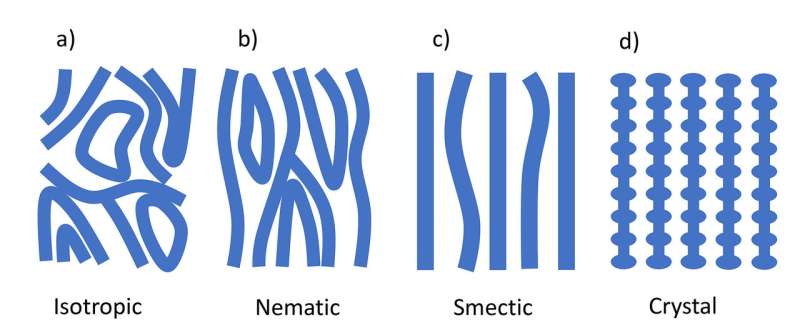Freezing electrons makes them get in line

New research published in Nature Communications suggests that electrons in a two-dimensional gas can undergo a semi-ordered (nematic) to mostly-ordered (smectic) phase transition, which has been discussed in physics theory but never seen in practice before.
"Imagine that we could build an ice skating rink for electrons, and the electrons had to move along the surface; they couldn't move up and down, so they just had to skate around each other," said Michael Manfra, the Bill and Dee O'Brien Chair Professor of physics and astronomy at Purdue. "When you cool them down to very low temperatures and place them in a magnetic field, they sort of lock in step with each other; they line up like soldiers on a battlefield."
The Purdue team used a high-purity growth technique, called molecular beam epitaxy, to grow a semiconductor material (gallium arsenide) that confines electrons to a two-dimensional layer. Then they cooled the sample down to near absolute zero in a dilution refrigerator. Voltage probes along the length of the conductor measured resistance, which is a function of temperature and magnetic field.
The researchers believe they induced a transition from a nematic to a smectic state. To make this happen, conditions had to be perfect – extremely cold, on a very clean surface, in a perpendicular magnetic field.
"At high temperatures, it looks isotropic, like electrons randomly dancing around one another," Manfra said. "As it starts to cool down, the electrons lock into columns, and we see the resistance take off and peak. Then as we go to very low temperatures, it turns over again. This indicates a transition from a nematic to smectic phase."
These results aren't what the team originally went looking for – it was an accidental discovery that helps them better understand how electrons interact with one another in controlled environments. Discoveries in physics often happen this way; in the right conditions, serendipitous events can occur.
More information: Q. Qian et al. Possible nematic to smectic phase transition in a two-dimensional electron gas at half-filling, Nature Communications (2017).
Journal information: Nature Communications
Provided by Purdue University





















